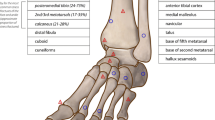Abstract
Background
Injury to the lower extremity is one of the most common traumatic injuries encountered in both combat and civilian situations. Improvements in sterile technique, the use of antibiotics, bony fixation, and microvascular reconstruction have shifted the management paradigm from predominantly amputation to limb salvage. We reviewed acute lower-extremity reconstruction in a single suburban trauma center and identified common characteristics of functional and adverse outcomes.
Methods
The records of patients treated at a level I trauma center for lower-extremity injuries and requiring plastic surgery consultation or intervention were reviewed. Common demographic and clinical characteristics for three functional outcomes (range of motion, return to work, and ambulation) and three adverse outcomes (venous thromboembolism, rehospitalization, and operative revision) were compared.
Results
Of the 4039 patients treated for a lower-extremity traumatic injury over a 6-year period, 92 (2.3%) patients met the inclusion criteria. Severity of injury was a common determinant of outcome. On long-term follow-up, the majority of patients were ambulatory (n = 50), albeit frequently with some deficit in range of motion or gait disturbance. When modifiable characteristics were evaluated, an increased length of time to soft-tissue coverage was associated with both an increased incidence of venous thromboembolism and range-of-motion deficit.
Conclusions
Delayed definitive soft-tissue coverage of lower-extremity traumatic wounds is associated with thromboembolic events and range-of-motion deficits. Involvement of a plastic surgeon in a multi-disciplinary trauma team could expedite definitive wound coverage and improve clinical outcomes of lower-extremity trauma. Future research evaluating the impact of early plastic surgery involvement on outcome measures is necessary.
Level of Evidence: Level IV, risk/prognostic study
Similar content being viewed by others
References
Aldea PA, Aldea GS, Shaw WW (1987) A historical perspective on the changing methods of management for major trauma of the lower extremity. Surg Gynecol Obstet 165:549–562
Gustilo RB, Anderson JT (1976) Prevention of infection in the treatment of one thousand and twenty-five open fractures of long bones: retrospective and prospective analyses. J Bone Joint Surg Am 58:453–458
Gustilo RB, Mendoza RM, Williams DN (1984) Problems in the management of type III (severe) open fractures: a new classification of type III open fractures. J Trauma 24:742–746
Bondurant FJ, Cotler HB, Buckle R et al (1988) The medical and economic impact of severely injured lower extremities. J Trauma 28:1270–1273
Johansen K, Daines M, Howey T et al (1990) Objective criteria accurately predict amputation following lower extremity trauma. J Trauma 30:568–572
McNamara MG, Heckman JD, Corley FG (1994) Severe open fractures of the lower extremity: a retrospective evaluation of the Mangled Extremity Severity Score (MESS). J Orthop Trauma 8:81–87
Russell WL, Sailors DM, Whittle TB et al (1991) Limb salvage versus traumatic amputation. A decision based on a seven-part predictive index. Ann Surg 213:473–480
Bonanni F, Rhodes M, Lucke JF (1993) The futility of predictive scoring of mangled lower extremities. J Trauma 34:99–104
Bosse MJ, MacKenzie EJ, Kellam JF et al (2001) A prospective evaluation of the clinical utility of the lower-extremity injury-severity scores. J Bone Joint Surg Am 83-A:3–14
Bosse MJ, McCarthy ML, Jones AL et al (2005) The insensate foot following severe lower extremity trauma: an indication for amputation? J Bone Joint Surg Am 87:2601–2608
Bosse MJ, MacKenzie EJ, Kellam JF et al (2002) An analysis of outcomes of reconstruction or amputation after leg-threatening injuries. N Engl J Med 347:1924–1931
MacKenzie EJ, Bosse MJ, Kellam JF et al (2006) Early of long-term work disability after major limb trauma. J Trauma 61:688–694
Pollak AN, McCarthy ML, Burgess AR (2000) Short-term wound complications after application of flaps for coverage of traumatic soft-tissue defects about the tibia. The Lower Extremity Assessment Project (LEAP) Study Group. J Bone Joint Surg Am 82-A:1681–1691
Godina M (1986) Early microsurgical reconstruction of complex trauma of the extremities. Plast Reconstr Surg 78:285–292
Karanas YL, Nigriny J, Chang J (2008) The timing of microsurgical reconstruction in lower extremity trauma. Microsurg 28:623
Francel TJ, Vander Kolk CA, Hoopes JE, Manson PN, Yaremchuk MJ (1992) Microvascular soft-tissue transplantation for reconstruction of acute open tibial fractures: timing of coverage and long-term functional results. Plast Reconstr Surg 89(3):478–487
Author information
Authors and Affiliations
Corresponding author
Ethics declarations
Funding
None.
Conflict of interest
Iris A. Seitz, Justine C. Lee, Suela Sulo, Varun Shah, Manoj Shah, Matthew L. Jimenez, and Loren S. Schechter declare that they have no conflict of interest.
Patient consent
For this type of study formal consent is not required.
Ethical approval
For this type of retrospective study formal consent is not required.
Rights and permissions
About this article
Cite this article
Seitz, I.A., Lee, J.C., Sulo, S. et al. Common characteristics of functional and adverse outcomes in acute lower-extremity trauma reconstruction. Eur J Plast Surg 40, 235–244 (2017). https://doi.org/10.1007/s00238-016-1268-5
Received:
Accepted:
Published:
Issue Date:
DOI: https://doi.org/10.1007/s00238-016-1268-5




